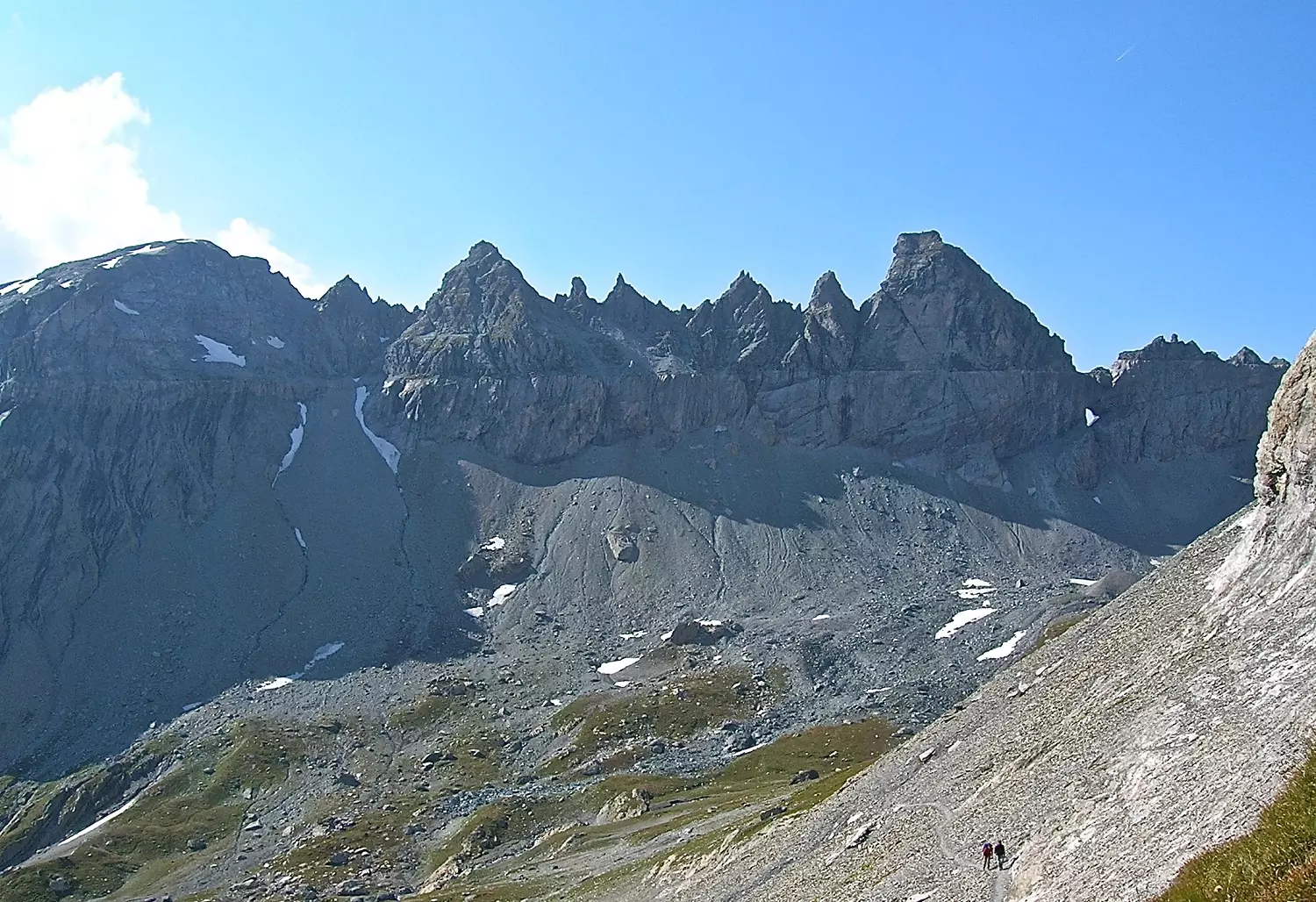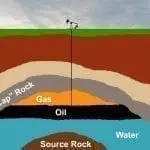(The Glarus Overthrust is visible as the horizontal line cutting across these Alps)
[Originally published as The Overthrust Enigma]
How could older rocks move over younger rocks for a distance of over 100 km? J. G. C. Anderson describes the Glarus overthrust in the Swiss Alps where older rocks are on top of younger layers:
… the main contacts between nappes [thrust sheets] are often remarkably smooth; for example, along the famous Glarus overthrust Permian red beds overlie Lower Tertiary flysch [shale/conglomerate mix], the zone of disturbance being exceedingly thin, even of the order of 10 cm.¹
Sometimes the contact at the Glarus Overthrust is knife edge (scroll down to the young man in white pointing at the seam) in certain locations! That is, it appears to be continuously deposited.
We seem to have two options,
- a catastrophic explanation or
- this is the order they were actually deposited and the geologic column is refuted (Cambrian, Ordovician, Silurian etc.).
There are a number of overthrusts around the world where old strata lie on top of younger rocks. In many cases these extend for miles with no evidence of movement at the contact. Native American scholar Vine Deloria comments,
This concept has been liberally applied when the fossils do not line up in a coherent evolutionary sequence, even when there has been no evidence that strata have been disturbed. Overthrust is thus often used to hide anomalies and explain inconsistencies in the progression of fossils.³
Vine Deloria offered these perceptive remarks on overthrusts:
The rocks are not always found in the proper order; sometimes a formation has simpler fossils on the top and more complex ones on the bottom. To solve this problem, geologists invented the “overthrust.” This term is applied to formations in which, in theory, some layers of older strata are pushed up over younger strata, disrupting the sequence of fossils. This concept has been liberally applied when the fossils do not line up in a coherent evolutionary sequence, even when there has been no evidence that strata have been disturbed.4
Writing in 1908, Thomas Mellard Reade had this to say about the geological paradox of large overthrusts:
In attempts to unravel some of the weightier problems of geology it has lately been assumed that certain discordances of stratification are due to the thrusting of old rocks over those of a later geological age. Without in any way suggesting that the geology has in any particular instance been misread, I should like to point out the difficulties in accepting the explanation looked at from a dynamical point of view when applied on a scale that seems to ignore mechanical probabilities. … I venture to think that no force applied in any of the mechanical ways known to us in Nature would move such a mass, be it ever so adjusted in thickness to the purpose, even if supplemented with a lubricant generously applied to the thrust-plane. 5
Have we found a definitive solution to this problem in over a century of research? Fridtjof Riis, who is a senior geologist at the Norwegian Petroleum Directorate and a recipient of the Brøgger Prize (Geological Survey of Norway’s honors award), gives the answer. He is totally honest about the overthrust enigma:
A thrust nappe consists of rocks that have been pushed several kilometers. The lower boundary of a thrust nappe is defined by a thrust fault. … A typical thrust nappe rests more or less horizontally on top of a younger sequence of strata. … What kind of forces were able to push large mountain masses more than a hundred kilometers on top of younger layers? … Two mountains stand out as the Scandinavian reference sites [Norway/Sweden] of thrust nappes where older types of bedrock lie on top of Cambro-Silurian sedimentary rocks. … the thrust nappes on the Norwegian side must have been transported at least 100 kilometers relative to the Swedish Cambro-Silurian sequence. … to many people it seemed physically impossible that such large distance thrust faulting could have taken place.
Notes:
1) The Structure of Western Europe by J. G. C. Anderson (Pergamon, NYC, 1978), p. 160.
2) YES – Young Earth Science by Jay Hall (IDEAS, Big Spring, TX, 2014), pp. 106-108, 141, 175.
3) Evolution, Creationism and Other Modern Myths by Vine Deloria (Fulcrum Pub., Golden, CO, 2002), p. 92.
4) Ibid.
5) quoted in The Structure of Geology by David Kitts (SMU Press, Dallas, 1977), pp. 79, 80.








Sorry, but that last quote seems to be cut off short, leaving the question “Have we found a definitive solution to this problem…” up in the air: “to many people it seemed physically impossible…” suggests that such a view was held in a past, but now what “seemed” to be impossible might not seem that way. Do we need to look up the source for ourselves to see if there is an explanation that needs refutation? Please continue and correct this.
David:
Thanks for the helpful thoughts.
Here is the source of the last quote:
http://www.npd.no/en/Topics/Geology/Temaartikler/Seven-mysteries-in-Norwegian-geology/The-fourth-mystery/
Riis makes this interesting statement:
“The thrust faults are created over a long time as the sum of many earthquake movements, which must then have reactivated the same sliding surfaces repeatedly. In modelling the mechanics of thrust movements, it is still considered an open question why the friction in the sliding surfaces during major earthquakes is so low that the large thrusts can occur.”
At Heart Mountain (MT/WY) the rocks above are 250 million years older than the rocks below.
It has been suggested by mainstream geologists that this large rock movement happened catastrophically (30 minutes):
https://www.livescience.com/796-land-speed-record-mountain-moves-62-miles-30-minutes.html
Blessings, Jay
Jay,
Enjoyed your article.
I believe that this is a real phenomenon. It can be explained in a Biblical Floodmodel without compromise. I have called this model Noah’s Upheaval (NU) Flood Theory. I have a Kindle/Amazon eBook available called, “Solving the Genesis Flood”. The simple answer is that you can push one brick, maybe 50 brick, one in front of the other. But you will not be able to push a thousand bricks, without crushing the first bricks, while not moving any of the bricks after these crushed bricks. Mountains do not show any evidence of only being crushed on one end, but instead; show a shortening throughout their total width. Therefore, all elements of the mountain must have initially moved at the same momentum before it came to a stop! How fast must these mountains have been traveling to have traveled over a 100 km? All the world mountains have these same charateristic.
God Bless!